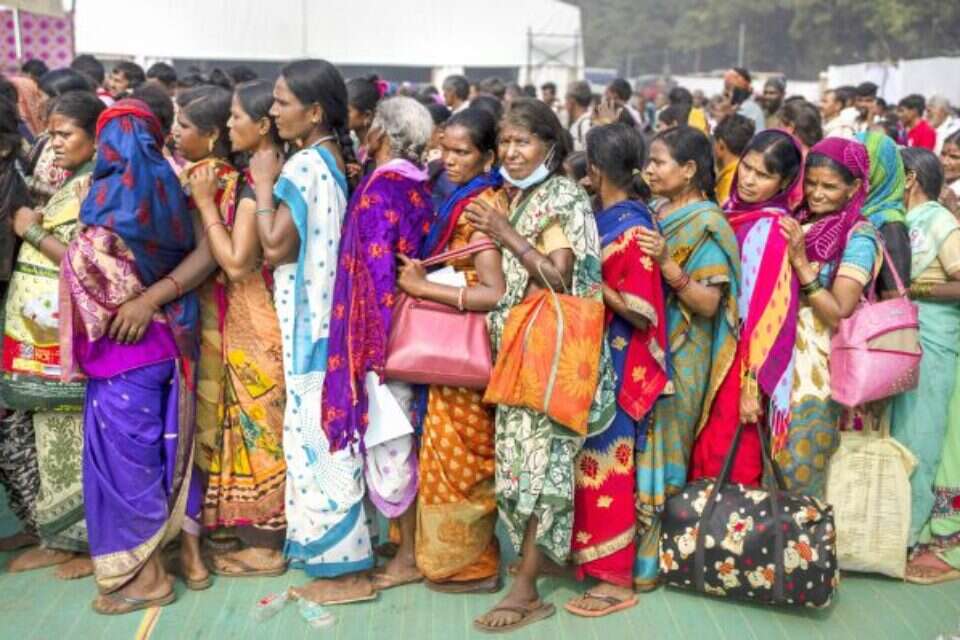The complex relationship between India and China is not a new matter, and the tag battle is one of its aspects.
In terms of the data, it seems that in the question "Who has the bigger one?"
China has overtaken India in almost every possible category: territory, defense budget, navy and middle class.
According to the predictions, this coming April, India will snatch from China the title it has held for many years: "the most populous country in the world".
It will be the first time since the 1950s that a country other than China will hold the title.
In recent years, the Chinese have faced a significant population contraction, greater even than those experienced by Japan or South Korea.
Last year China's population shrank for the first time in six decades, a historic turn that has significant implications for its economy.
In China, not only will the size of the population decrease, but their age profile will also change.
The dominant faction will no longer be of working-age citizens but the elderly nearby.
The number of Chinese citizens over the age of 65 will double by 2050.
In contrast, India's population has more than tripled in the last decades since its partition from Pakistan - from 361 million in 1951 to more than 1.4 billion today.
Every month the number of new residents in the country increases by a million.
More women, less workers
In light of the social practice of favoring men in the giant country, this is an excellent opportunity to observe the place of Indian women in the demographic picture of India and the changes that have taken place over 75 years.
For this purpose, it is useful to examine two key parameters: the fertility rates of women in India and the mortality rates.
Female mortality rates in India are a product of social factors, compared to the biological factors that may explain male mortality rates.
Tradition, religion and economic hardship combined to determine a situation where raising a girl could be a death blow for a family - and therefore many work to "get rid" of childhood ahead of time.
As a result, India today suffers from a disproportionate ratio of boys to girls - a phenomenon that has only gotten worse.
The 2011 census shows that in the age group 6 and under, the ratio of boys to girls is 1,000 to 914 - that is, one out of every 10 female fetuses does not make it to birth, or is destroyed immediately after.
However, a survey conducted about a year ago by the Indian government indicates that for the first time in history there are more women than men in India.
Women's participation in the labor market is an important indicator for understanding demography and the change that has taken place in the status of women, but perhaps in the case of India we may be dealing with an exception.
In a strange way, in recent years there has been a decrease in the participation of women in the labor market, and this is in contrast, and perhaps it should be said precisely because of the economic growth experienced by India.
This pattern is evident both among the women of the village and among the women of the city.
The reason lies in the fact that the expansion of women's access to education did not undermine social norms too much but actually allowed them to upgrade within the system.
Studies show that women with a secondary education married men who were more educated and had a higher family income, which reduced the incentives for their participation in the labor market.
In fact, in Indian culture even among the most enlightened circles, a woman who does not work is still an expression of high social status and with the increase in the number of new millionaires and the expansion of the middle class, their number actually increases.
Ironically, the participation of women in the labor market during the colonial period was close to 30%.
India's economic growth process has also led to several changes in favor of women.
The reforms of the 1990s, which opened the Indian economy to the world and led to the expansion of the country's service sector, were the opening shot on the way to the process of improving the status of women in the country.
The opening of telephone service centers owned by Western companies accelerated the entry of millions of women into the labor market.
The nature of the office work, and the employee training programs made them attractive among women in a way that was able to receive the blessing of the husband or parents.
However, the round-the-clock work also included night shifts and the arrival of women to the pick-up points of the transports from remote areas.
These increased the need to make the streets of India safer for women.
Either through the lighting of the streets and infrastructure development, or through the expansion of the operation to establish comfort spaces that were given the slogan: "toilets before temples" under Modi's election campaign in 2014. Until recently, in various regions throughout India and even in the big cities, women hardly left their doorsteps after the hour Five in the evening for fear of the many dangers that the darkness of the night brings with it.
like in Israel
Demography is neither destiny nor part of India's dharmic law, and what will ultimately decide India's position and its relative position vis-à-vis China are the courses of action that Delhi decides to take.
To enjoy the demographic dividend, India will have to find productive work for its millions of young people.
The growth will put enormous pressure on India's resources, economic stability and society, and the consequences will reach far beyond its borders.
As a country at the forefront of the climate crisis, which already faces extreme weather events 80% of the year, dwindling resources like water could become decisive factors in what India's future population looks like.
As a country that looks at Israel with shining eyes as a model of security, economic and agricultural success, it would be right to remember that Israel did this with the help of its women.
were we wrong
We will fix it!
If you found an error in the article, we would appreciate it if you shared it with us















